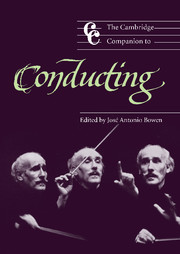12 - The American tradition
from Part II - History
Published online by Cambridge University Press: 28 September 2011
Summary
The history of conducting in America is at once bound to the profession's European fortunes and characterized by various attempts to break free from those bonds. And if the separation of New World from Old World may never be complete, that is no argument against that struggle's centrality in American musical life. Set against the privileged role of the symphony orchestra in America, the relationship to commercial enterprise, transformations in technology, and the continually growing power of celebrity, is the tale of a young nation both drawn to the artistic traditions of the cultures that spawned it and increasingly determined to forge its own path.
The religious traditions on which American society was largely formed did not encourage the growth of a new musical culture. In addition to the practical problems, Puritan Boston and Quaker Philadelphia had religious objections that contributed to the slow start of concert life. But with growing urbanization, a burgeoning sense of nationhood, and the discovery that music could be morally edifying, the seeds of formal concert life took root. Founded in 1815, Boston's Handel and Haydn Society was primarily devoted to the performance of sacred choral works, while a Philharmonic Orchestra founded by Gottlieb Graupner in 1810 lasted for fifteen years, performing the first complete American Messiah in 1818. The multipurpose band, however, remained the most common musical ensemble in nineteenth-century America, and like the rest of American musical concert life at mid-century, variety was its hallmark.
- Type
- Chapter
- Information
- The Cambridge Companion to Conducting , pp. 163 - 177Publisher: Cambridge University PressPrint publication year: 2003



